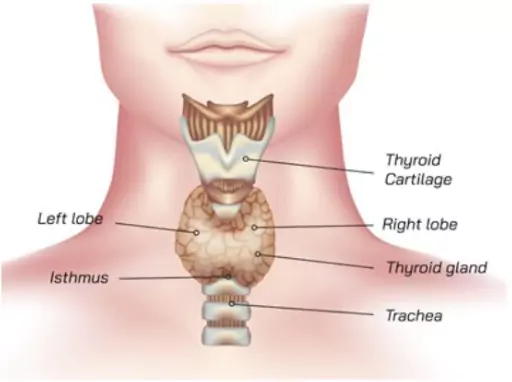Nuclear medicine has emerged as a safe and precise method for diagnosing and treating thyroid disorders, especially hyperthyroidism and thyroid cancers.
About Nuclear Medicine
- Nuclear medicine is a special branch of medical imaging. It uses tiny amounts of radioactive materials (called radiotracers) to diagnose and treat diseases—especially cancers, thyroid problems, heart conditions, and bone disorders.
How Does It Work?
- A radiotracer (a radioactive substance) is either swallowed, injected, or inhaled.
- It travels through the body and gets absorbed by the organ or tissue being studied.
- A gamma camera detects the radiation given off by the tracer and creates images of the inside of the body.
- These images help doctors check both the structure and function of organs.
- Common Radionuclides Used: Technetium-99m, iodine, gallium, thallium, xenon—each used for specific organs or diseases.
Some common types of nuclear medicine scans include:
- Kidney (Renal) Scan – Checks kidney function and blood flow.
- Thyroid Scan – Measures thyroid activity and spots nodules.
- Bone Scan – Detects fractures, cancer, infections, or arthritis.
- Heart (Cardiac) Scan – Assesses blood flow and heart muscle health.
|
What is the Thyroid?
- The thyroid is a small, butterfly-shaped endocrine gland located at the front of the neck, just below the Adam’s apple, in front of the trachea (windpipe).
 Despite its small size, it plays a critical role in regulating several vital functions of the body through the secretion of hormones. Despite its small size, it plays a critical role in regulating several vital functions of the body through the secretion of hormones. - The thyroid primarily secretes two important hormones: Triiodothyronine (T3) and Thyroxine (T4)
Disorders of the Thyroid Gland
- Hypothyroidism: Caused by insufficient hormone production.
- Hyperthyroidism: Occurs when the gland overproduces thyroid hormones.
- Thyroid Cancer
- Goitre: an abnormal enlargement of the thyroid.
|
Iodine and its Role
- Iodine is essential for thyroid hormone synthesis.
- Adults need ~150 µg/day; children need ~120 µg/day; pregnant/lactating women need ~300 µg/day.
- The thyroid gland stores >80% of the body’s iodine.
- Iodine deficiency is defined by the WHO as <100 µg/L of urinary iodine.
Development of Radioactive Iodine Therapy
- The concept originated in the 1930s with researchers speculating on its potential for medical use.
- Saul Hertz (Massachusetts General Hospital) pioneered the practical application for treating thyroid conditions.
- Iodine-131 emits gamma rays for imaging and beta particles for tissue destruction.
|
Radioactive Iodinie
- Stable Isotope: Iodine-127 is naturally occurring and stable.
- Radioactive Isotopes: Over 40 exist, most man-made via nuclear reactors/cyclotrons.
- Medically Relevant Isotopes: Iodine-123, Iodine-124, Iodine-125, and Iodine-131 (the latter discovered in 1938, with an 8-day half-life).
Therapeutic Use in Thyroid Disorders
- Hyperthyroidism
- This treatment is used for overactive thyroid conditions like toxic goitre or nodules.
- Taken as Oral medicine, it targets and destroys only the overactive thyroid cells, helping to bring hormone levels back to normal.
- Thyroid Cancer
- After surgery, a small dose of radioactive iodine (Iodine-131) is used to scan the body for any remaining cancer or spread.
- Higher doses are used to destroy leftover thyroid tissue or treat stubborn cancers.
- Theranostics is a method that combines treatment and diagnosis—it uses one medicine to both see the cancer using gamma rays and treat it using beta particles.
Radioactive Iodine Therapy in India
- Diagnosis: A radioactive substance called Technetium-99m is used to scan the thyroid for non-cancerous (benign) conditions. It’s safe for imaging because it stays active only for a short time.
- Treatment: Iodine-131 is given by mouth in fixed doses to treat thyroid problems. Its use is strictly monitored and regulated.
- Safety Measures: Patients are kept in special isolation rooms after treatment until their radiation levels are low enough. They are also given clear safety instructions for after they go home to protect others from exposure.
- Not Allowed in Pregnancy: This treatment is not safe during pregnancy or breastfeeding. Women of childbearing age are tested for pregnancy before treatment.
- Side Effects: Most people have mild and temporary side effects, like dryness or swelling, which can be managed with medicines and drinking plenty of fluids. Regular check-ups are done every 6–8 weeks.
Significance of RAI
- Minimally invasive compared to surgery.
- Effective for both benign and malignant thyroid conditions.
- Aligns with the global trend towards personalised medicine.
![]() 21 Jul 2025
21 Jul 2025

